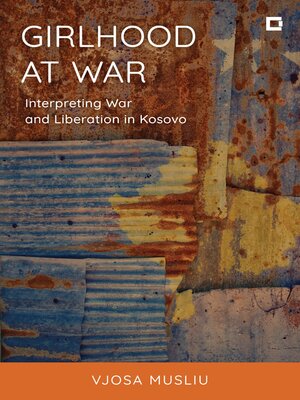Girlhood at War
ebook ∣ Interpreting War and Liberation in Kosovo · Creative Interventions in Global Politics
By Vjosa Musliu

Sign up to save your library
With an OverDrive account, you can save your favorite libraries for at-a-glance information about availability. Find out more about OverDrive accounts.
Find this title in Libby, the library reading app by OverDrive.



Search for a digital library with this title
Title found at these libraries:
| Library Name | Distance |
|---|---|
| Loading... |
This book tells the true story of a young girl growing up during the Kosovo war and its immediate aftermath following Kosovo's liberation by NATO troops in 1999. Through her embodied experiences, the book exposes the tangible and everyday acts and events of the war, providing brutal insight into the impact of war and the politics of subjugation.
At the outset of the book (in 1998), Vjosa's view of the world, as a young child, is organized in clear dichotomies: the good Albanians and the evil Serbs; the brutal Serbian military shelling Albanian civilians and the angelic NATO airplanes bombing Serbian military sites. This Manichean worldview starts to unravel after Vjosa and her family are chased away from their home by the Serbian military and moved to the suburbs. There, surrounded by mostly poor and uneducated fellow Albanians, she gradually discovers the layers of her family's socio-economic privileges. Though unequipped with the language to verbalize it, she is tormented by the idea that her family's comparatively higher socio-economic status is the reason why they are spared by the Serbian military.
When the war ends in 1999, and the NATO tanks fill the narrow streets of her hometown as Serbian military tanks leave, Vjosa believes she received her own 'happily ever after'. She celebrates her thirteenth birthday happily wearing a US military uniform, holding an unbearably heavy unloaded gun as she becomes the favorite interpreter of the American NATO troops. She spends several months after the war occasionally translating between angry Albanians who now seek revenge against Serbs and NATO troops who insist on not picking sides; showcasing the impossibility of (re)building Kosovo with "both-sides-ism" becoming the modus operandi of the international intervening structures.
At the outset of the book (in 1998), Vjosa's view of the world, as a young child, is organized in clear dichotomies: the good Albanians and the evil Serbs; the brutal Serbian military shelling Albanian civilians and the angelic NATO airplanes bombing Serbian military sites. This Manichean worldview starts to unravel after Vjosa and her family are chased away from their home by the Serbian military and moved to the suburbs. There, surrounded by mostly poor and uneducated fellow Albanians, she gradually discovers the layers of her family's socio-economic privileges. Though unequipped with the language to verbalize it, she is tormented by the idea that her family's comparatively higher socio-economic status is the reason why they are spared by the Serbian military.
When the war ends in 1999, and the NATO tanks fill the narrow streets of her hometown as Serbian military tanks leave, Vjosa believes she received her own 'happily ever after'. She celebrates her thirteenth birthday happily wearing a US military uniform, holding an unbearably heavy unloaded gun as she becomes the favorite interpreter of the American NATO troops. She spends several months after the war occasionally translating between angry Albanians who now seek revenge against Serbs and NATO troops who insist on not picking sides; showcasing the impossibility of (re)building Kosovo with "both-sides-ism" becoming the modus operandi of the international intervening structures.







